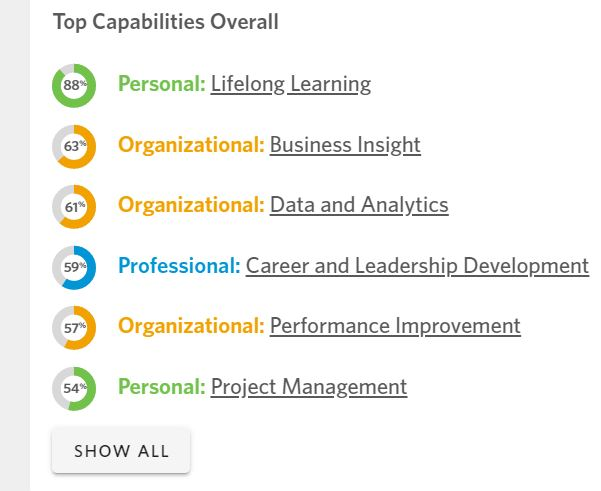ATD Blog
The New Learning Plans Are Here!
Mon Nov 02 2020

When we released the new learning plan feature of ATD’s Talent Development Capability Model self-assessment, I was excited to try it out. Maybe this is a testament to how boring my life is during the pandemic, but the new feature is terrific. It can help any talent development professional, at any stage of their career, continue to develop. After all, lifelong learning is a key capability in the field.
If you haven’t seen the Talent Development Capability Model site or taken the new self-assessment, make some time to complete it. The self-assessment enables you to rate your proficiency on the skills and knowledge included in the new Capability Model. To complete the assessment, log in to your td.org account and go to td.org/capability-model and click “Access the Model.” You do not need to be an ATD member to access this feature, but you must have a profile so your assessment and plan can be saved.
Once you reach the interactive model, select the “My Assessment” tab at the top of the page. Evaluate yourself on all three domains (personal, professional, and organizational) by highlighting the relevant area on the model graphic. Choose the domain you wish to assess yourself against then select each capability to rate your competency on the statements listed.
The self-assessment is on a five-point scale from least to most proficient. Be honest with yourself. This is for your own personal and professional development, so it’s important to reflect on your skills and knowledge and embrace a growth mindset. If you don’t have time to complete it in one sitting, it will automatically save for later. However, 30 minutes should be more than enough time to finish it.
Once you have completed your self-assessment, you may view your overall results by selecting the “My Report” tab to see how you rate overall for each domain. Scroll a bit further down the page and you will see all capabilities ranked from the highest to lowest score. To see more detail on a specific topic, including general learning resources, click on the underlined name of the capability.

The next step is to choose a learning path and create your own tailored learning plan. Select “My Learning Plan” at the top of the page and go to the “My Learning Path” tab to select from several predetermined paths such as instructional designer or coach learning path. If you’re interested in pursuing one of ATD’s credentials, the Associate Professional in Talent Development (APTD) or the Certified Professional in Talent Development (CPTD), you may choose it as your learning path. Your self-assessment will be compared to just the statements that are tested on the exam for that certification. You may also choose your own adventure and select the “self-guided” learning path where you can select the capabilities on which you plan to focus your learning.
In the example below, I chose the CPTD path to see where my knowledge fell short. \[NOTE: The proficiency score does not predict how well you will do on the exam, merely how familiar you are with the skills and knowledge covered.\]

The learning path helped me to focus on the areas where I most needed to shore up my knowledge. Areas where I fell short of the expected proficiency level were listed, and ATD learning resources (both free and paid) were suggested. You can add your own items from any source to keep all your professional development activities in one place and on plan. I chose a few ATD resources to add to my learning plan: a book, TD at Work, and a short course. Once I completed the item, I marked it as completed and moved on to my next planned learning item. I was prompted to reassess myself so I could see where I have closed gaps or still have work to do. It’s a great way to plan your professional development, and in my case, I also used it to plan my activities to meet the recertification requirements for my APTD.
To date, more than 6,500 talent development professionals have taken the self-assessment. The participating TD professionals rated themselves most highly on lifelong learning, training delivery and facilitation, communication, emotional intelligence and decision making, and project management. The capabilities with the lowest ratings thus far are data and analytics, change management, technology application, knowledge management, and talent strategy and management. How do you stack up?
For more information and a demonstration of the new learning plan feature, view our recent webcast webcasts.td.org/webinar/3614.
You've Reached ATD Member-only Content
Become an ATD member to continue
Already a member?Sign In
More from ATD
